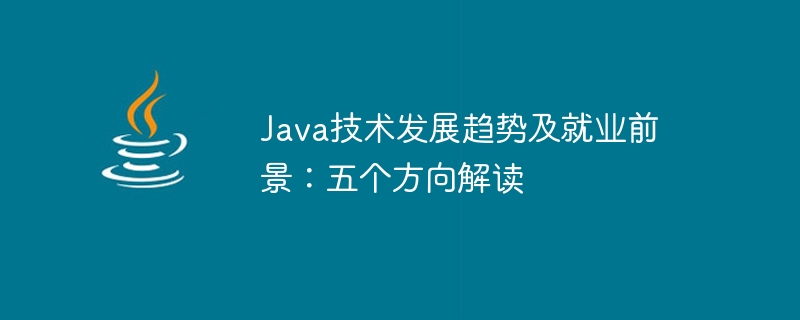Home >Java >javaTutorial >Interpret the five directions of Java technology: development trends and employment prospects
Interpret the five directions of Java technology: development trends and employment prospects
- 王林Original
- 2024-01-30 09:29:051357browse

In recent years, Java technology has been widely used and recognized in the field of software development. As a cross-platform programming language, Java has great advantages in enterprise-level application development, and also shows great potential in big data, cloud computing, artificial intelligence and other fields. This article will interpret the development trends and employment prospects of Java technology from five directions.
First direction: enterprise-level application development
In the context of information construction and digital transformation, the demand for enterprise-level application development continues to grow. As a mature and stable programming language, Java can meet the needs of enterprise-level applications. Whether it is a Web application, a large enterprise system or an e-commerce platform, Java technology has good adaptability and scalability. Therefore, employment opportunities are very broad for talents with Java development skills.
Second direction: Big data field
The arrival of the big data era has brought massive data resources to enterprises, so the technical requirements for processing and analyzing big data are getting higher and higher. As a high-performance programming language, Java has the ability to handle big data. Big data frameworks such as Hadoop and Spark are also written in Java language. Therefore, mastering Java technology, especially technologies related to big data, will be of great help in employment.
Third direction: cloud computing
With the popularity of cloud computing, more and more enterprises are migrating applications to the cloud. As a cross-platform language, Java can run on multiple cloud platforms, so talents with Java development skills have great employment opportunities in the field of cloud computing. For Java developers with cloud computing experience, they have certain technical advantages.
Fourth Direction: Mobile Application Development
The rapid development of the mobile Internet has led to a growing demand for employment in the field of mobile application development. As the main development language of the Android operating system, Java has become an essential skill for developing Android applications. Mastering Java technology can help developers easily build powerful Android applications. In addition, by mastering Java technology, you can develop cross-platform mobile applications and improve development efficiency.
Fifth Direction: Artificial Intelligence
Artificial intelligence is one of the hottest technical fields at the moment, and Java, as a high-performance and widely used programming language, is also used in the field of artificial intelligence. Java provides many artificial intelligence-related libraries and frameworks, such as TensorFlow, DL4J, etc. Mastering Java technology combined with relevant knowledge of artificial intelligence will provide more employment possibilities.
In summary, Java technology has broad employment prospects in the fields of enterprise-level application development, big data, cloud computing, mobile application development and artificial intelligence. For developers with solid basic knowledge of Java and practical experience in related fields, it will be easier to obtain employment opportunities. Therefore, for those who want to make a difference in the IT industry, it is very necessary to learn and master Java technology. Only by constantly learning and updating your skills can you gain a place in this highly competitive job market.
The above is the detailed content of Interpret the five directions of Java technology: development trends and employment prospects. For more information, please follow other related articles on the PHP Chinese website!
Related articles
See more- What are the key points of the development trend of integrated electronic information systems?
- Java technology optimization guide to improve database search performance
- What are the employment prospects of C#?
- Understand the employment prospects of Python and grasp the skills demand and market competition.

